a web page by Don Roberson |
 |
The occurrence of Peregrine Falcon in central California, including Monterey County, is complex. There are resident birds that breed here in remote eyries, mostly along the Big Sur coast. There are wintering individuals that arrive here from breeding sites far to the north (like those that regularly use the Embassy Suites sign in Seaside, above), and there are passage migrants in fall and spring. Three subspecies occur locally, but have differing timing patterns. This web project introduces these variations. It is something that I have only recently become attuned to, as ebird permits observers to enter Peregrines by subspecies. It is something worth learning, and I'm just starting. A starting point is to understand that for field identification there a just two essential age groups: (1) adults in basic plumage and (2) juvenal-plumaged birds in fall migration and early winter [these molt into basic plumage by spring]. These two plumages are easily separated: adults are barred below, while juvenals are streaked below. Adults have yellow lores, while juvs have bluish lores. This shows very nicely on these photos (below):
|
|||
 |
|||
 |
|||
| The three American races of Peregrine range from large dark birds from the northwest, F. p. pealei [Peale's Peregrine], to typical Peregrines across the continental west, F. p. anatum [Continental Peregrine], to pale arctic breeders, F. p. tundrius [Tundra Peregrine]. The maps below are from Wheeler (2003), but a red dot has been added to show the location of Monterey. | |||
|
|||
The maps show breeding range in pink, resident range in purple, and wintering range in blue. We have resident Continental Peregrines here in Monterey County. We also likely have a lot of wintering and migrant Continental Peregrines in MTY, coming from as far away as central Alaska. Peale's Peregrine breeds from the Aleutian Islands south to Vancouver Island, and then winters along the Oregon-California coast. Peale's Peregrine must be a regularly wintering bird here, plus additional migrants must pass through Oct-Nov, and probably Feb-Mar. There are no published specimens of Tundra Peregrine from MTY, but the subspecies was not even recognized until 1968, and most collections have not been searched to discover any. The only reports of Tundra Peregrines from MTY have been from this fall: 9 Sep 2008 near Salinas (B.L. Sullivan) and 10 Nov 2008 Salinas R. mouth (juv., Dave Tetlow). If you look at the map, you see this is an Arctic breeder that 'leapfrogs' the wintering range of other Peregrines and winters well south (all the way to South America). In California, the map in Wheeler (2003) shows it wintering from Santa Barbara south, along the coast, and in the Imperial Valley. Although there are differences between male and females, and females average larger, the differences are rather subtle. Males tend to be bluer above with blacker tails, but this is all subjective. Size can likely be distinguished when two are together, or when the observer has much experience, but otherwise I have not tried to figure out sex in any of the following photos. We turn first to adult-plumaged birds. |
|||
Historically there were 24 known eyries of Peregrine in MTY, but they all were abandoned by the mid-1960s due to the egg-shell thinning properties of DDT and derivatives. The banning of DDT in the 1970s, and the re-introduction project in the 1980s by the Santa Cruz Predatory Bird Research Group, headed by Brian Walton, brought this species back to recovery in MTY. All re-introduced birds, and all eggs replaced in wild nests, were on the anatum subspecies (White et al. 2002). Today there are 6-9 breeding pairs along the Big Sur coast (Roberson 2002). There is a lot of variation in the plumages of Continental Peregrines. While our resident birds may be rather rusty below, many migrants from farther north are not. And then there is a lot of variation in the width of the malar stripe. |
|||
 I
believe that this Peregrine at the Salinas R. mouth 31 Jan 2007 is a
Continental Peregrine (great photo © Jeff Poklen). It has a very
wide malar but it does not cover the entire auriculars — thus this
malar pattern is less extensive than the bird shown above. The chest is
white but the belly barred; and the underwings are quite dark. The lack
of streaking or spotting in the lower auriculars apparently rules out pealei (Wheeler 2003), and the dark underwings likely rule out tundrius
(which typically as a much thinner malar stripe), but note how little
orange or buff color there is on the underparts. Therefore it does not
look like our resident birds. I suspect this is a migrant from rather
far north, perhaps even central Alaska. I
believe that this Peregrine at the Salinas R. mouth 31 Jan 2007 is a
Continental Peregrine (great photo © Jeff Poklen). It has a very
wide malar but it does not cover the entire auriculars — thus this
malar pattern is less extensive than the bird shown above. The chest is
white but the belly barred; and the underwings are quite dark. The lack
of streaking or spotting in the lower auriculars apparently rules out pealei (Wheeler 2003), and the dark underwings likely rule out tundrius
(which typically as a much thinner malar stripe), but note how little
orange or buff color there is on the underparts. Therefore it does not
look like our resident birds. I suspect this is a migrant from rather
far north, perhaps even central Alaska. |
|||
I also believe that the bird shown below, with a California Gull as prey from Rio Del Mar, Santa Cruz Co., on 26 Jan 2008, is a Continental Peregrine, but from somewhere rather far north of us. It also lacks orangey tones in the underparts, but is medium gray in upperpart tone and has a very broad malar (but not a complete helmet). The wings do not reach the tip of the tail. |
|||
 |
|||
However, we can tell by their non-orangey plumage they are not from the population of our local breeding Peregrines. They likely breed thousands of miles north of us. No wonder the "nest box" put up by Embassy Suites is an abject failure! No Peregrine has ever checked it out for breeding purposes, although one may roost near it. |
|||
Bill's flight shot (below) tends to confirm these points. To me the underwings looks less darkly barred than some of the birds Jeff Poklen photographed on local beaches, which may suggest that the Embassy bird is from a locale even farther north . . . and closer to Tundra Peregrine on this character. There is tremendous overlap between subspecies, so lots of birds are intermediate (White et al. 2002, Wheeler 2003). |
|||
Tradition says that the Embassy Suite and Aquarium Peregrine arrive on Halloween and leave on Tax Day (April 15). My MTY data-base shows records from Embassy Suites as early as late Sep (and 4 Oct for the Aquarium) and as late as 1 May, but late Oct–mid-April is likely a very good average arrival and departure pattern. |
|||
Tundra Peregrines apparently winter north to Santa Barbara, so it may be supposed that a few could winter here. Certainly there must be passage migrants spring and fall. Fall migration begins in September (Wheeler 2003). |
|||
As most birders know, most of the Peregrines from southern Canada and the United States were subject to intensively efforts to re-establish them in the 1980s & 1990s. Many of our birds today originate from those efforts. According to White (2002) and Wheeler (2003), all the re-introduction projects in western North America involved only anatum birds. East of the Rockies, however, the efforts to re-establish the species were considered more critical, and involved birds from all three North American population plus two races from Europe. Thus in eastern North America one may encounter birds with a higher mix of characters, including dark pealei-like birds. Here in the West, we do not have that problem. No re-introduction efforts were made in Alaska, for example, so our migrant birds are all "pure" stock. |
|||
| The final subspecies is Peale's Peregrine, breeding from coastal Alaska to British Columbia. There are actually two subpopulations, with Aleutian birds averaging less dark than the really dark B.C. breeding birds. Coastal MTY is smack dab in the middle of their wintering range. Although the two flight shots below are scanned from a distant slide, I think it is of an adult Peale's Peregrine at Big Sur R. mouth on 2 Nov 2003 (© D. Roberson). | |||
|
|||
There is a specimen of Peale's from Pacific Grove on 1 Jan 1910 (Roberson 2002), and 6 records of Peale's in the ebird database for Monterey County within the last 4 years, all between 16 Oct–5 Mar. All but one are from the immediate coast (Pt. Pinos, Asilomar, Salinas R. mouth) except for one at Cone Peak 21 Oct 2006 (B.L. Sullivan). The very dark plumage of Peale's Peregrines parallels that of the dark suckleyi Merlins that winter here on the central coast. Both populations breed in the humid forested areas of the Pacific Northwest, and average much darker than 'typical' birds. |
|||
Our Peregrines take a wide variety of avian prey, apparently focusing locally on Rock Pigeons, gulls, ducks, coots, and large shorebirds. The young Peale's Peregrine that is featured in these photos (© D. Roberson) had taken a coot at Shoreline Park, Mountain View, and the feathers were flying as it consumed the meal (below). |
|||
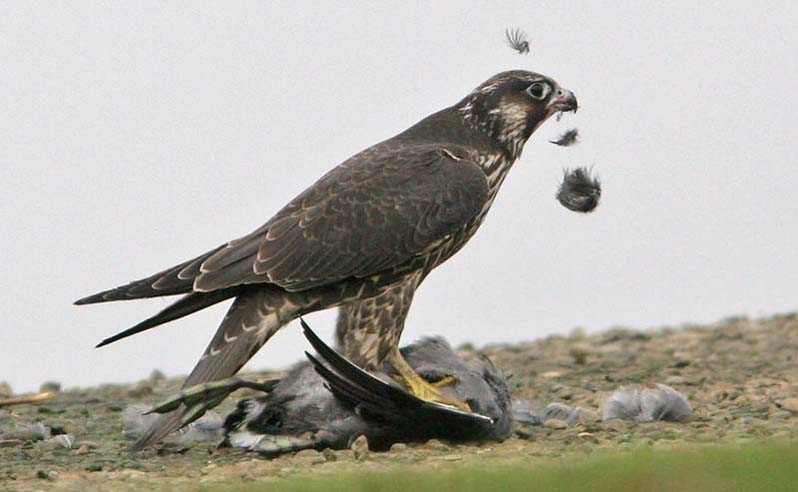 |
|||
Photos: All photos © Don Roberson, all rights reserved. Literature cited:
|

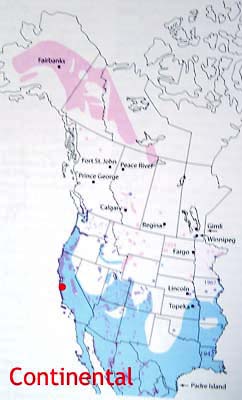
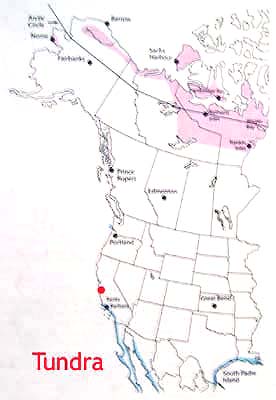
 Here
is an example of our resident Continental Peregrine, taken 20 Oct 2006
at Big Sur R. mouth (© D. Roberson). First thing to notice is that
the malar stripe is so broad that it covers the entire auriculars – the
entire dark heard is like a helmet. Second, notice the extensive
orangey wash in the underparts, typical of P. p. anatum in
moderate latitudes. There is barring across the flanks and belly, but
not on the breast. The overall 'tone' of the upperparts in 'medium,'
neither particularly dark nor particularly pale.
Here
is an example of our resident Continental Peregrine, taken 20 Oct 2006
at Big Sur R. mouth (© D. Roberson). First thing to notice is that
the malar stripe is so broad that it covers the entire auriculars – the
entire dark heard is like a helmet. Second, notice the extensive
orangey wash in the underparts, typical of P. p. anatum in
moderate latitudes. There is barring across the flanks and belly, but
not on the breast. The overall 'tone' of the upperparts in 'medium,'
neither particularly dark nor particularly pale. 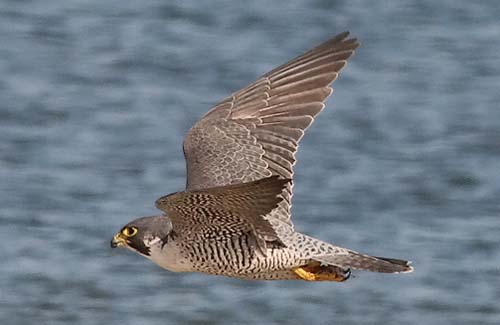 The
upperparts of this bird (another wonderful shot © J. Poklen) are
medium in tone, with decidedly paler rump and uppertail coverts, and a
barred tail that is also in the mid-gray range. More shots are on
The
upperparts of this bird (another wonderful shot © J. Poklen) are
medium in tone, with decidedly paler rump and uppertail coverts, and a
barred tail that is also in the mid-gray range. More shots are on 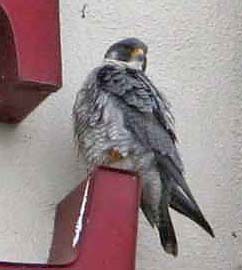 This
type of Continental Peregrine plumage is very like the birds that
winter on the Embassy Suites (right, photo 27 Mar 2006 © D.
Roberson ), and on the "smoke-stack" on Monterey Bay Aquarium. Some
believe it is the same couple of birds that use these 'traditional'
perches, but there is rather little actual evidence one way or the
other. Wintering Peregrines have high fidelity to specific wintering
spots, and may live 16-20 years (White et al. 2002), so presumably the
same birds return each winter. Presumably the older returning birds
establish dominance at these perches, but as these are highly desired
locales for Peregrines, I suspect that other Peregrines use them when
the "wintering resident" pair is not around (such as one seen on
Embassy Suites 3 July 2006; Bill Hill). Peregrine pairs do not migrate
together, so it is possible that the two birds seen annually are not
actually paired to each other, but rather have high fidelity to a
wintering perch. Or they may be a pair bond — there are plenty of
things we don't know.
This
type of Continental Peregrine plumage is very like the birds that
winter on the Embassy Suites (right, photo 27 Mar 2006 © D.
Roberson ), and on the "smoke-stack" on Monterey Bay Aquarium. Some
believe it is the same couple of birds that use these 'traditional'
perches, but there is rather little actual evidence one way or the
other. Wintering Peregrines have high fidelity to specific wintering
spots, and may live 16-20 years (White et al. 2002), so presumably the
same birds return each winter. Presumably the older returning birds
establish dominance at these perches, but as these are highly desired
locales for Peregrines, I suspect that other Peregrines use them when
the "wintering resident" pair is not around (such as one seen on
Embassy Suites 3 July 2006; Bill Hill). Peregrine pairs do not migrate
together, so it is possible that the two birds seen annually are not
actually paired to each other, but rather have high fidelity to a
wintering perch. Or they may be a pair bond — there are plenty of
things we don't know.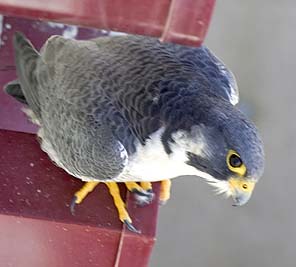 In
March 2005, Bill Hill obtained permission to take photos of the Embassy
Peregrines from the roof. This shot, looking down on one bird, shows a
Peregrine with mid-range gray back, a rather medium-wide malar stripe,
a gray forecrown with only a trace of white band on the forecrown, and
a white chest. I think these points all fit Continental Peregrine best.
Again, I also think this bird must nest far to the north of us, due to
the lack of orangeish wash to auriculars or underparts.
In
March 2005, Bill Hill obtained permission to take photos of the Embassy
Peregrines from the roof. This shot, looking down on one bird, shows a
Peregrine with mid-range gray back, a rather medium-wide malar stripe,
a gray forecrown with only a trace of white band on the forecrown, and
a white chest. I think these points all fit Continental Peregrine best.
Again, I also think this bird must nest far to the north of us, due to
the lack of orangeish wash to auriculars or underparts. 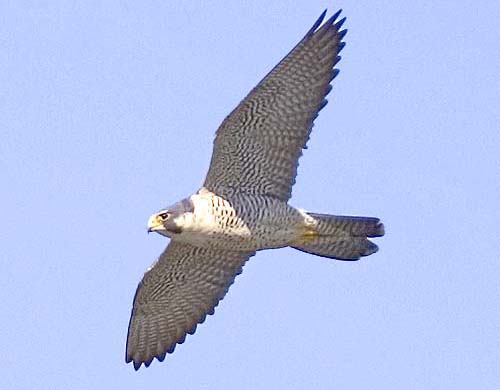 In
fact, DNA studies of the three American subspecies have shown no
greater variance then populations of the same European subspecies in
northern and southern Sweden (White et al. 2003). In other words, there
is substantial gene flow between populations and the 'edges' of what we
are calling subspecies are very 'muddy.' We can probably only recognize
really typical individuals of any race.
In
fact, DNA studies of the three American subspecies have shown no
greater variance then populations of the same European subspecies in
northern and southern Sweden (White et al. 2003). In other words, there
is substantial gene flow between populations and the 'edges' of what we
are calling subspecies are very 'muddy.' We can probably only recognize
really typical individuals of any race. 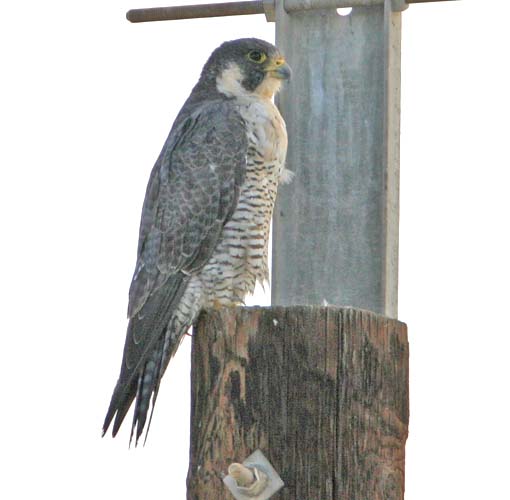 There
are no photos (yet) of Tundra Peregrine in MTY; indeed, there are only
a few sight records in fall migration. Adults differ from Continental
Peregrine by averaging paler with broader white forecrown; averaging
longer wings (reaching the tip of the tail); they tend to have a very
narrow malar stripe; and they tend to have a pinkish-buff wash to the
belly. These features seem mostly present in this photo from the south
end of the Salton Sea, Imperial Co. (24 Nov 2006 © D. Roberson).
Wheeler (2003) shows tundrius as wintering in the Imperial Valley.
There
are no photos (yet) of Tundra Peregrine in MTY; indeed, there are only
a few sight records in fall migration. Adults differ from Continental
Peregrine by averaging paler with broader white forecrown; averaging
longer wings (reaching the tip of the tail); they tend to have a very
narrow malar stripe; and they tend to have a pinkish-buff wash to the
belly. These features seem mostly present in this photo from the south
end of the Salton Sea, Imperial Co. (24 Nov 2006 © D. Roberson).
Wheeler (2003) shows tundrius as wintering in the Imperial Valley. 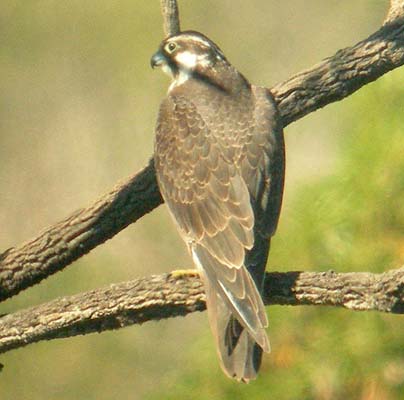 Many Tundra Peregrines have a malar even narrower than the one above. This photo of a juv tundrius
from Santa Barbara (right, ~Dec 2006 © Oscar Johnson) shows that
narrower malar stripe very well. Indeed, the narrow malar may be the
most important feature on this race. Juvenal Tundra may show a very
pale whitish-buff head, and may stand out as "blonde" Peregrines
(Wheeler & Clark 1995, Wheeler 2002). An extensive, pale
supercilium — as on this bird — may be another typical feature.
Many Tundra Peregrines have a malar even narrower than the one above. This photo of a juv tundrius
from Santa Barbara (right, ~Dec 2006 © Oscar Johnson) shows that
narrower malar stripe very well. Indeed, the narrow malar may be the
most important feature on this race. Juvenal Tundra may show a very
pale whitish-buff head, and may stand out as "blonde" Peregrines
(Wheeler & Clark 1995, Wheeler 2002). An extensive, pale
supercilium — as on this bird — may be another typical feature. 
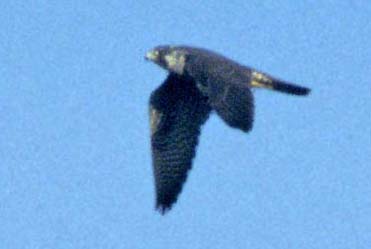
 It
is an extremely dark bird above, with rump about the same tone as the
blackish tail, and is extensively dark on the underwings. It has a
medium-broad malar stripe and no hint of orange or rust coloration
below. The scanned flight shots are not good enough to determine if the
auriculars are streaked, but that point is quite obvious on this
juvenal bird (left) from south San Francisco Bay on 8 Nov 2008 (left
© D. Roberson). Apparently, streaked auriculars is a diagnostic
character of pealei (although some paler individuals may lack it; Wheeler 2003).
It
is an extremely dark bird above, with rump about the same tone as the
blackish tail, and is extensively dark on the underwings. It has a
medium-broad malar stripe and no hint of orange or rust coloration
below. The scanned flight shots are not good enough to determine if the
auriculars are streaked, but that point is quite obvious on this
juvenal bird (left) from south San Francisco Bay on 8 Nov 2008 (left
© D. Roberson). Apparently, streaked auriculars is a diagnostic
character of pealei (although some paler individuals may lack it; Wheeler 2003). 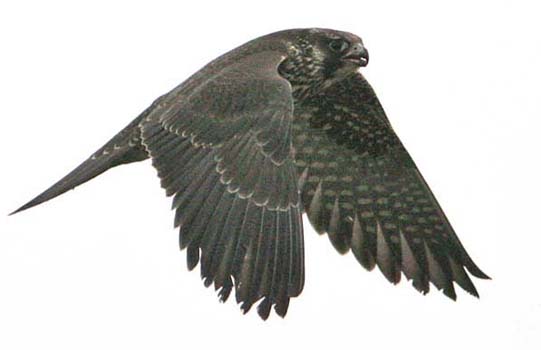 The
very dark look is also evident in flight (right; same bird), and
includes the very dark underwings. I will certainly try to identify the
subspecies of local Peregrines that are encountered, if looks are good
enough, but it must be cautioned that there is a range of overlap
between these three types.
The
very dark look is also evident in flight (right; same bird), and
includes the very dark underwings. I will certainly try to identify the
subspecies of local Peregrines that are encountered, if looks are good
enough, but it must be cautioned that there is a range of overlap
between these three types.